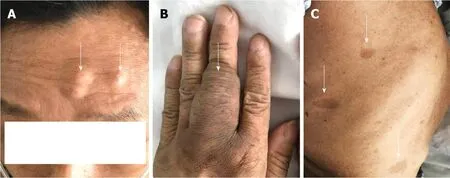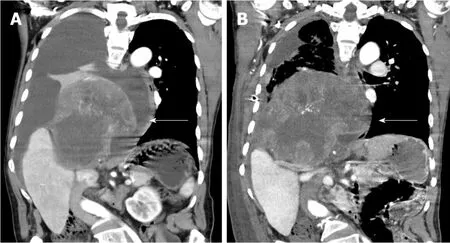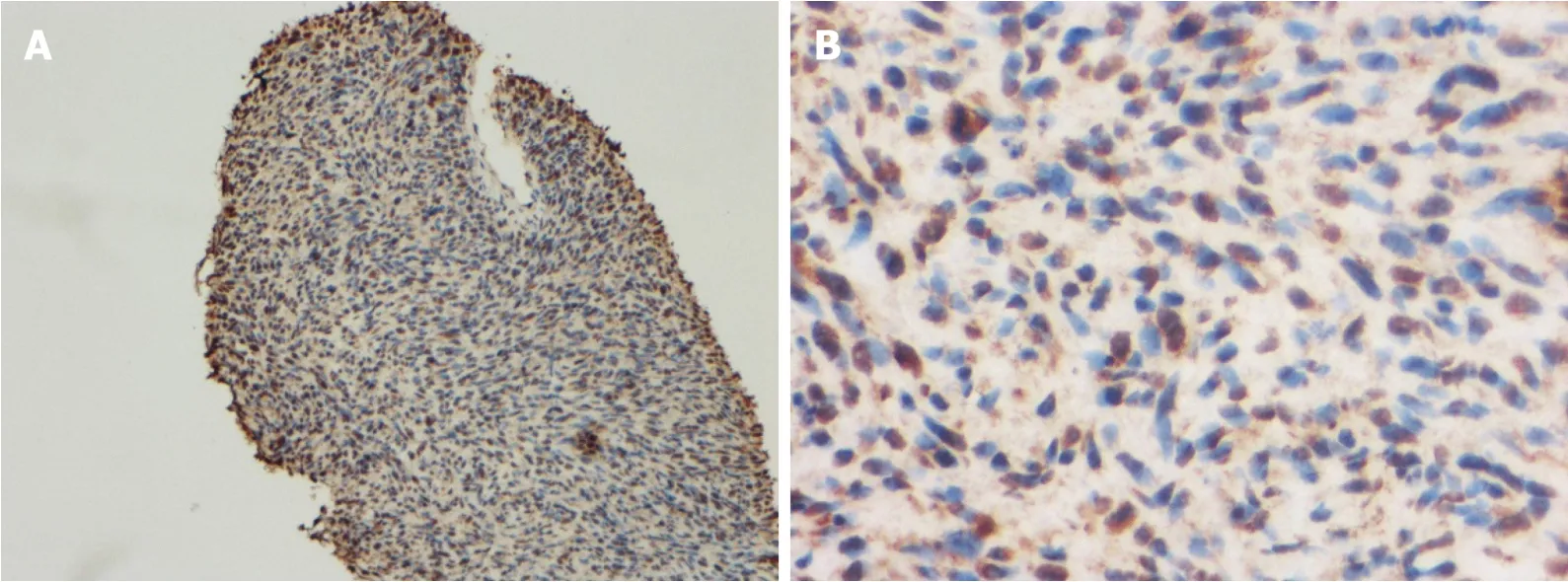Multiple neurofibromas plus fibrosarcoma with familial NF1 pathogenicity:A case report
Yang Wang,Xiao-Fan Lu,Lu-Lu Chen,Ying-Wei Zhang,Bing Zhang
Yang Wang,Bing Zhang,Department of Radiology,The Affiliated Nanjing Drum Tower Hospital of Nanjing University Medical School,Nanjing 210008,Jiangsu Province,China
Xiao-Fan Lu,Research Center of Biostatistics and Computational Pharmacy,China Pharmaceutical University,Nanjing 210009,Jiangsu Province,China
Lu-Lu Chen,Ying-Wei Zhang,Department of Respiration,The Affiliated Nanjing Drum Tower Hospital of Nanjing University Medical School,Nanjing 210008,Jiangsu Province,China
Abstract
Key words: Multiple neurofibromas;Fibrosarcoma;Neurofibromatosis type 1 pathogenicity;Pseudochylothorax;Pleural cavity;Case report
INTRODUCTION
Neurofibromatosis (NF) is a genetic disease consisting of seven types,of which types 1 to 4 are caused by a dominant autosomal gene mutation[1,2].Neurofibrosarcoma is a malignant tumor derived from cells surrounding the peripheral nerves and usually occurs in the limbs.Neurofibrosarcoma seldom metastasizes to other parts of the body,although it may reach the lungs by extensive spread along nerve tissues[3].This disease predominantly affects young and middle-age adults,and sometimes arises in patients with NF type 1.However,it remains unclear whether the origin of neurofibrosarcoma is directly linked to the incidence of NF type 1,as no reports have been published on this issue.Here,we report a case of NF1-positive multiple neurofibromas with malignant fibrosarcomatous transformation in the pleural cavity.
CASE PRESENTATION
Chief complaints
The patient was admitted to our hospital due to cough and sputum with intermittent fever for more than one month.
History of present illness
The patient had no obvious cause of cough and excessive phlegm before one month.The sputum was white and easy to cough;the cough was not related to body position,activity,etc.Fever and chills were not observed.
History of past illness
Normal health was fair.No history of chronic diseases such as hypertension,diabetes,or coronary heart disease,but he had a history of scoliosis for decades,and a history of multiple lipomas for many years.
Personal and family history
No clear family history.
Physical examination upon admission
Temperature was 36.9°C,pulse rate was 133 beats/min,respiratory rate was 25 breaths/min,blood pressure was 119/87 mmHg,and body mass index was 24 kg/m2.Pigmentation was visible throughout the body with multiple lipomas.
Laboratory examinations
White blood cell count was 12.29 × 109/L,NE% was 89.21%,hemoglobin was 151 g/L,platelet count was 296 × 109/L,and no obvious abnormalities were noted in liver and kidney function.C-reactive protein was 69.4 mg/L,thyroid-stimulating hormone was 5.17 uIU/mL,and both triiodothyronine and thyroxine were normal.
Imaging examinations
Chest computed tomography (CT) revealed occupancy in the right lower lobe and right hilar,right lower lobar inflammation with consolidation,and right pleural effusion;color Doppler ultrasound revealed solid right adrenal gland occupancy with metastatic potential,left cervical lymph node swelling;no malignant tumor cells were found in the biopsy,and no obvious enlarged lymph nodes on the bilateral clavicle.
The 51-year-old male was admitted to our hospital in January 2018 with fever accompanied by coughing,chest tightness and asthma for more than one month.Multiple subcutaneous nodules,which were soft and mobile,were observed in the forehead and limbs (Figure 1A and 1B).Multiple areas of pigmentation were seen throughout the body such as the right hypochondrium of the torso (Figure 1C).The spine showed curvature to the right side,and thoracoabdominal contrast-enhanced CT imaging revealed a large mass in the right thoracic cavity,accompanied by atelectasis and extensive hydrothorax on the right side (Figure 2).No malignant cells were observed in the hydrothorax smear and the hydrothorax chylous test was positive.Our examination indicated a high possibility of lymphangiomatosis and right pleural space occupation was initially suspected.To further confirm the diagnosis of chylothorax,triglyceride and cholesterol tests were performed on the pleural fluid.The results revealed a low level of triglycerides and a cholesterol-totriglyceride ratio exceeding 1 in the pleural fluid,which suggested a diagnosis of pseudochylothorax.The preliminary diagnosis was NF type 1,which was pathologically confirmed by a subsequent thoracoabdominal subcutaneous biopsy.Bultrasound-guided percutaneous lung puncture was performed to clarify the nature of the pleural space occupation,and the pathological results indicated a spindle cell malignancy suggestive of a high-grade sarcoma.The definitive diagnosis was neurofibrosarcoma (Figure 3).To determine the existence of a familial genetic factor,the NF1 gene was sequenced from peripheral blood samples from the patient and his daughter.The results showed that both carried the pathogenic gene of NF1 (chr17q11| NM_000267.3) with the c1885G>A mutation located in Exon 17.The patient refused surgery and chemoradiotherapy,and died two months later.
FINAL DIAGNOSIS
The final diagnosis in this patient was NF1-positive multiple neurofibromas with malignant fibrosarcomatous transformation in the pleural cavity.
TREATMENT
The patient refused surgery and chemo-radiotherapy.
OUTCOME AND FOLLOW-UP
The patient died two months later.
DISCUSSION
This patient was classified as a case of NF1-positive dominant inheritance.NF type 1 rarely involves internal organs,although histological evidence of disease in this case was found in the mediastinum.The majority of neurofibromas in the mediastinum originate from the spinal or intercostal nerves and are located in the posterior mediastinum[4],while the tumor in this case was in the middle mediastinum.This may be associated with the anatomical position of the vagus nerve.Moreover,although NF tends to be benign,in this case,a malignant sarcomatoid tumor was accompanied by ipsilateral pleural effusion,which is rarely encountered.Based on our initial examinations,we made a diagnosis of chylothorax caused by lymphangiomatosis.Lymphangioma is a rare tumor that originates in the lymphatic system,and may develop in any region of the body through which lymphatic vessels pass[5].On CT imaging,a cystic mass in the mediastinum often appears as a homogeneous lowdensity area[6,7],although other forms of the disease may be present if the tissue composition of the mass varies[8,9].In the case described here,preliminary examinations showed that the patient's pleural fluid was turbid,bloody and chylomicron-positive,which,in combination with the large mass in the pleural cavity,suggested chylothorax.However,further examinations led to the diagnosis of pseudochylothorax.Pseudochylothorax is a type of pleural effusion that is less common than chylothorax,and is predominantly caused by cholesterol accumulation[10,11].In the case of pseudochylothorax,the proportion of cholesterol-totriglyceride in the fluid always exceeds 1,with cholesterol > 200 mg/dL and triglyceride < 110 mg/dL.

Figure1 Multiple subcutaneous nodules throughout the body.
CONCLUSION
We report the first case of NF1-positive multiple neurofibromas with malignant fibrosarcomatous transformation in the pleural cavity.

Figure2 Changes in the patient’s tumor size from day 1 to day 24 after hospitalization.

Figure3 Microscopic findings show neurofibrosarcoma.
 World Journal of Clinical Cases2020年7期
World Journal of Clinical Cases2020年7期
- World Journal of Clinical Cases的其它文章
- Sarcopenia in patients with colorectal cancer:A comprehensive review
- Thoracic hydatid disease:A radiologic review of unusual cases
- Clinical significance and prognostic value of tumor necrosis factor-α and dickkopf related protein-1 in ankylosing spondylitis
- Reconstruction of Paprosky type lllB acetabular bone defects using a cup-on-cup technique:A surgical technique and case series
- Depression and myocardial injury in ST-segment elevation myocardial infarction:A cardiac magnetic resonance imaging study
- Long-term survival of two patients with recurrent pancreatic acinar cell carcinoma treated with radiofrequency ablation:A case report
